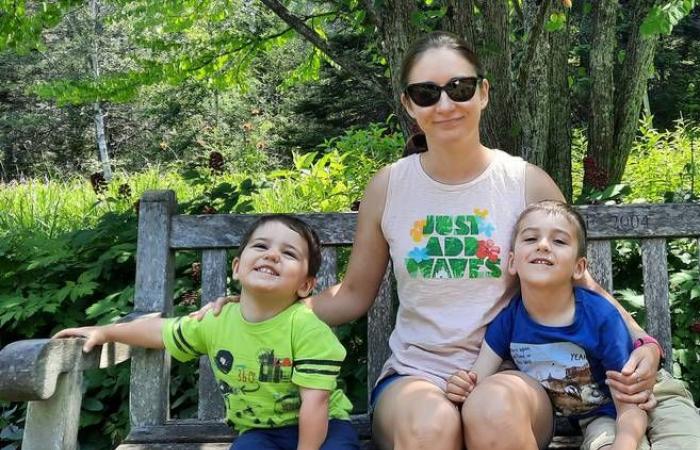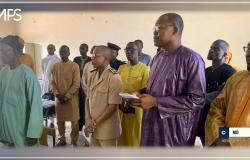Back at home, a feeling of dizziness comes over her as she puts her groceries in the refrigerator. “It’s probably another migraine,” thinks the mother. After pulling herself together, she unzips her baby’s winter coat, but leaves him in his stroller so as not to wake him.
The situation escalated around 2:30 p.m. while she was vacuuming. “As I bent down to pick up an object, I felt very dizzy. I later learned that I was completely paralyzed on my right side.”
Without her knowing it, a blood clot had lodged in her brain.
At this time, Stéphanie “doesn’t know at all” that she is having a stroke, but she understands very well that something is wrong. “At the time, I was still conscious. I remember saying to myself “I should call 911”. But she is incapable of it. The main person concerned confides that she faced this episode with serenity. “I said to myself, ‘I still had two beautiful boys.’”
The more time passes, the more the 26-year-old woman loses control of her means. Unable to move, she crashes to the floor and remains there until her ex-partner returns from work, around 4:45 p.m. He immediately dials 9-1-1, aware that Stéphanie is in the process of have a stroke and his life is in danger.
Everyone is at risk
A stroke results from a lack of oxygen supply to part of the brain. It can be caused by thrombosis or embolism, that is to say the migration of a clot or fatty deposit debris into the cerebral vessels.
Even if the memory of this event upsets her, Stéphanie today wishes to “send a message of hope and prevention to those who have experienced a stroke or to those who suffer its after-effects”.
On the occasion of stroke month and the tenth anniversary of the FAST awareness campaign launched in 2014 by the organization Cœur + AVC, the mother of two children considers it important to recall how such an accident can be “suddenly “.
Stéphanie holding her youngest child, in 2019, the year of her accident. (Stéphanie Dubé)
Young and with no known health problems, Stéphanie Dubé does not appear to have the “typical” profile of a stroke victim. “Everyone is at risk of having a stroke, regardless of age. Both the fetus in the womb of its mother and the athlete in excellent physical condition,” says Dr. Marie-Christine Camden, neurologist at the Hôpital de l’Enfant-Jésus in Quebec.
Acting quickly can be a matter of life and death, or can determine whether a person will live the rest of their life with after-effects. To help people identify the signs of stroke and recognize the urgency of the situation, the Heart + Stroke organization launched the FAST awareness campaign in 2014. Ten years later, although progress has been made, “there are still not enough people who recognize the signs,” judges the organization.
Progress but still a long way to go
In the past decade, the number of people in the country able to name at least two FAST signs of stroke has doubled, from two in 10 to more than four in 10, surveys conducted by Environics Research Group.
Dr. Camden took care of Stéphanie Dubé when she was taken to the emergency room. The neurologist was not surprised to see the young mother in postpartum to the hospital because this is a good time to have a stroke. The risk of stroke increases “considerably” after an episode of stress or after physical exertion.
Dr. Camden points out that there are several other known “silent” risk factors for stroke, such as diabetes, cholesterol, atrial fibrillation, obesity, physical inactivity, smoking and poor diet.
The urgency to act
What would have happened if the ex-spouse had never heard of the acronym? Could he have quickly recognized the signs of the accident? The blood clot had found its way into an area of the brain responsible for breathing. According to medical staff, Stéphanie was “minutes away from dying.”
In the case of a stroke, “you should not hesitate and call the emergency services as quickly as possible because every second counts,” says Dr. Camden bluntly.
Every day, Dr. Camden receives dozens of new stroke cases to treat. The paramedics know that the Enfant-Jésus Hospital is considered “the tertiary center” for treating patients who suffer a stroke in Quebec, reveals the neurologist.
“Patients are treated there as quickly as possible”, generally within 30 minutes. “It’s like a pit stop in F1,” she jokes to illustrate both the scale of the medical team and the speed with which all the members are working to find out why the circulation of blood to the brain is obstructed.
“Miraculous”
When Stéphanie regained consciousness at the hospital, the medical staff were stunned to see that their patient “had already regained her senses”.
“They told me, ‘you are blessed by the gods, you are miraculous’,” recalls the main person concerned, who returned home only a week after the incident. Even though Stéphanie experienced “a little difficulty” walking and climbing stairs for a few days, she did not need to pursue additional care following her hospital stay.
Many people living alone are “less advantaged” than Stéphanie and remain in agony much longer, notes the neurologist.
In addition to the fact that she was treated in a “very short” time frame, Stéphanie’s young age also “largely” explains the success of her treatment. “The brains of younger people have the ability to regenerate more quickly,” notes Ms. Camden.
Since her stroke, Stéphanie Dubé has taken up running and participated in several events, including the Lévis half-marathon. (Stéphanie Dubé)
In general, continues the spokesperson for Heart + Stroke, “it takes two years for the after-effects to be consolidated”. Some patients completely lose their motor skills, while others retain all their brain faculties. The lucky ones, like Stéphanie, escape such an accident unscathed.
Prevent, not cure
Since her accident, in addition to taking care of her children, Stéphanie has started a baccalaureate and has run several marathons.
Rather than letting herself be discouraged, Stéphanie decided to adopt better lifestyle habits. “I felt so lucky to be alive and not paralyzed.” Running has thus become a logical solution for the mother.
“Experiencing an event like this changes your perspective on life.”
— Stéphanie Dubé
Exactly six months after her stroke, on September 6, 2019, the woman who had never run before completed her first half marathon. As soon as she hits the starting line, a stream of tears streams down her cheeks.
The best way to prevent a stroke is to reduce risk factors, says Dr. Camden. A task that Stéphanie has dedicated herself to for five years, one race at a time.







